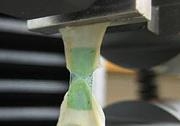Brain surgery without stitches
A breakthrough technology to seal surgical wounds without stitches will be developed for use in delicate brain surgery thanks to a major federal government grant.
A breakthrough technology to seal surgical wounds without stitches will be developed for use in delicate brain surgery thanks to a major federal government grant.

A breakthrough technology to seal surgical wounds without stitches will be developed for use in delicate brain surgery thanks to a major federal government grant.
A team led by Associate Professor John Foster of the UNSW Bio/Polymer Research Group (BRG) and Professor Marcus Stoodley, a neurosurgeon from Macquarie University, has been awarded a $213,000 development grant from the National Health and Medical Research Council.
Professor Foster's team is investigating potential applications of the world's first thin-film surgical adhesive that uses a unique combination of laser technology and biomaterials. Known as SurgiLux®, it is a natural, strong, flexible film that is compatible with living tissue and is based on the US Food and Drug Administration-approved chitosan, a biomaterial derived from crustacean shells. The film is simply placed over a wound or surgical incision and activated with a conventional infra-red clinical laser to effect closure.
Currently, wound closure in the cranium relies on sutures or "stitches", which can lead to infections and other medical complications.
"The application of SurgiLux® technology will both close and seal these wounds quickly and easily, with significant health and economic benefits," said the Parliamentary Secretary for Health, Mr Mark Butler, announcing the grant.
Read the full story at the Faculty of Science newsroom.
Media contacts: John Foster | j.foster@unsw.edu.au
Bob Beale | 0411 705 435 | bbeale@unsw.edu.au